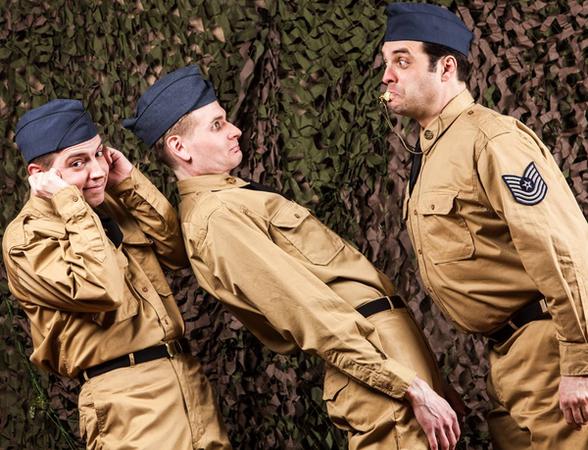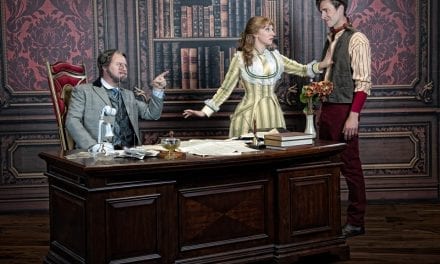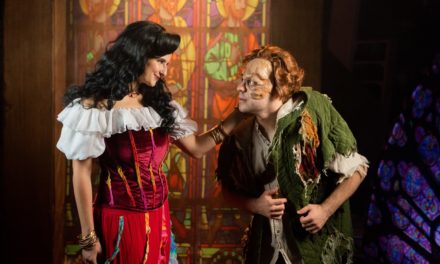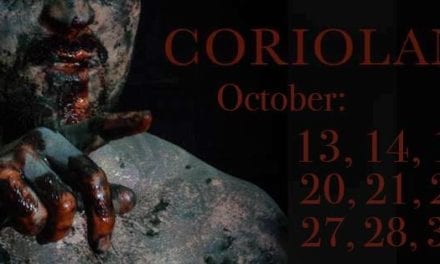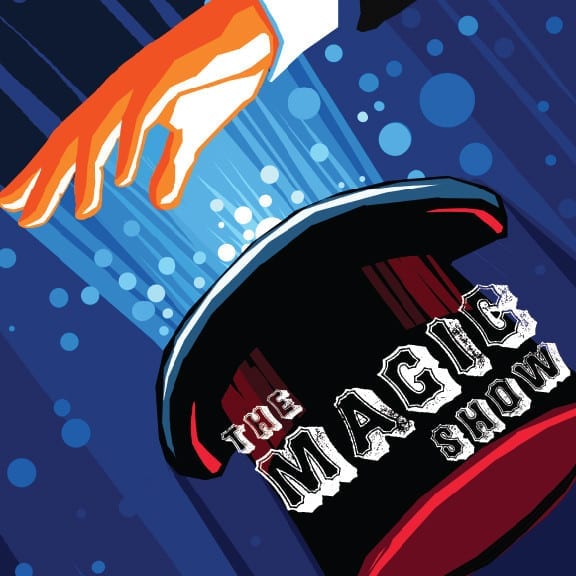WEST VALLEY CITY — No Time For Sergeants, based on the 1954 novel by Mark Hyman, has been enduringly popular, having been adapted into a teleplay, a comic book series, a television series, a film, and a Broadway play. The production underway at Hale Center Theater is a clear illustration of why this story remains a hit.
No Time for Sergeants tells the story of a simple-minded draftee named Will Stockdale (played by Justin Bruse), who joins the armed forces and, through a series of mishaps, misunderstandings, and mistakes, ensures a coveted position in the infantry for himself, his best friend Ben Whitledge (played by Greg Larsen), and Sergeant Kelly (played by Cody K. Carlson).
As the naive country bumpkin Stockdale, Bruse was in his element. He played the role with sincerity tinged with sweetness, and made the character of Stockdale—though a glaring archetype—wonderfully real. Bruse understood the motivations of his character so clearly that he was able to make the audience understand them as well. Because Stockdale wanted so badly for Ben Whitledge to get into the infantry, so did I. Bruse is also a very talented comic, and had some great moments of physicality as well as beautifully timed phrasing in his delivery. One scene that stood out for me was the scene in which Stockdale is sent to the military psychiatrist, played by Kevin B. Cottam. From the moment Bruse walked in and couldn’t figure out how to sit in the doctor’s reclining sofa, to the moment when the confused and agitated doctor receives counseling from Stockdale and is eventually led away in a straitjacket, I was nearly falling out of my chair laughing. There is something to be said for simple, classic comedy like this—it never stops being funny.
As Stockdale’s best friend, Larsen was endearingly earnest. He, like Bruse, performed in a way that was entirely believable while remaining outrageously entertaining. One aspect of Larsen’s performance I really enjoyed was the character vocalization he utilized, which was strangely cartoonish, but worked beautifully. His impish quality worked well against Bruse’s lumbering presence, and the two made quite the odd couple. Larsen’s pert guilelessness was enjoyable to watch, and I found myself rooting for him. There was a moment near the end of the play where Whitledge is convinced he is about to be court-martialed, and Larsen delivered a tour de force showing of Whitledge admitting his guilt and basically begging to be shot so that he can “die honorably.” Watching the diminutive Larsen struggle with the officers latched onto his arms and hearing him bleat about his accidental desertion was quite hilarious.
As Sergeant Kelly, Carlson was a crackling, energetic foil to Bruse’s slower-paced Stockdale. Carlson put me in mind of a firework waiting to explode, or a jar of brightly buzzing bees. He was disgruntled, cranky, and at times furious, and all of these things swam under a tightly bottled surface. This energy came leaking or bursting out in those moments of desperation, showering over the nonplussed Stockdale, who, through most of the play, has no idea how much grief he is causing his venerated sergeant. Carlson was certainly a highlight for me, and I would go back to see the play for his performance alone. In my mind, it takes a great heap of talent to make a character who does despicable things for entirely selfish reasons undeniably lovable, and that is exactly what Carlson does. Kelly is so annoyed by Stockdale that, at one point, he takes him to a bar with the intention of getting him drunk and into some mischief. The plan is foiled, and, as a result, the sergeant is stripped of his rank and sent to gunnery school with Stockdale. Were someone less likable in the role, I might have thought, “Good, he’s getting what he deserves.” Instead, I felt pity for the poor sergeant.
Another actor that caught my attention was Anthony LeRoy Lovato, who played several characters throughout the play. Many actors in the play did this as well, but Lovato played his with such variety and commitment to each one that he was a pleasure to watch.
One aspect of the play I particularly enjoyed was the clever and funny public service announcement that played at the beginning: one part nuclear bomb training (“Duck and Cover!”) and one part admonition to turn off your cell phones. Indeed, the whole design of the show’s setting was deliberate and well-executed. Set design by Kacey Udy seemed simplistic, but I could see how much work went into designing the platform on which most of the action took place, along with platforms that slid in to join the center. One feature of Udy’s design was very impressive: a Bellagio Fountain-like latrine complete with light show and dancing toilet lids that had me in stitches.
Lighting for the show, designed by Adam Flitton, was extremely well done. Soft, dappled lighting gave a great sense of nostalgia to the whole play, and I particularly liked a scene that took place in an airplane, wherein streaking light of blues, grays, and greens sailed by like a kaleidoscope of color, and it was very pretty.
I must applaud director Jennifer Parker Hohl for the pace of the show. The play is a long one, but it seemed to fly by. Hohl has managed to direct her actors in such a way that keeps things moving along at a fast clip, with dialogue jumping quickly and scene changes running smoothly. I always have to appreciate a director who can instill the importance of this aspect in her players, especially in a comedic show. Thanks to Hohl, her cast, and the creative team of No Time for Sergeants, I thoroughly enjoyed my visit to Hale Center Theater, and am now a fan of this classic play.

